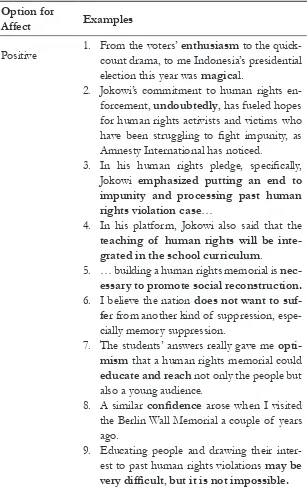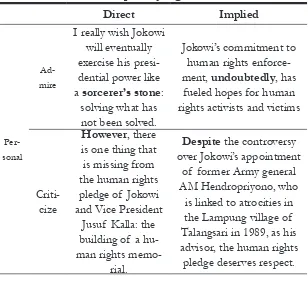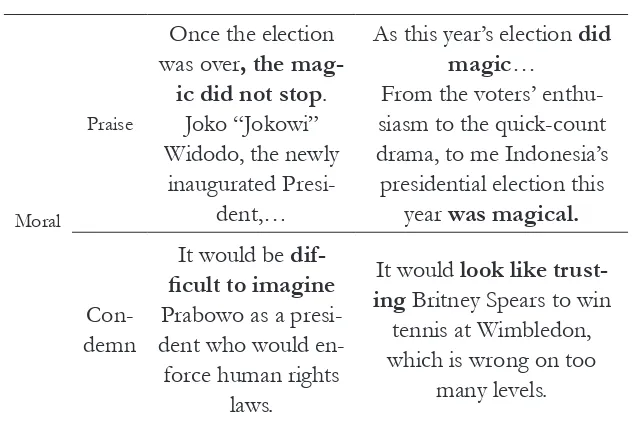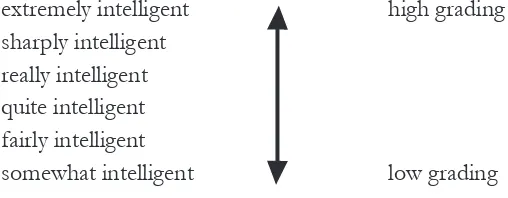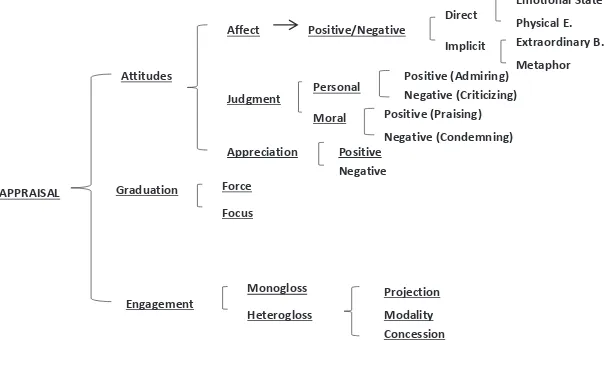POST OPINION “A HUMAN RIGHTS
MEMORIAL: JOKOWI AND THE
SORCERER’S STONE”
Pikir Wisnu Wijayanto
Telkom University, Indonesia [email protected]
Abstract
This study aims at examining the meaning of text in detail through metafunctions analysis with appraisal systems. The ap-praisal system is deployed in order to explore texts in detail from the perspectives of discourse semantics developed by James Martin and David Rose (2003). The data is taken from the opinion article column of the Jakarta Post (a national English newspaper in Indo-nesia), published on Thursday, October 23rd, 2014. The article
en-titled “A Human Rights Memorial: Jokowi and the Sorcerer’s Stone” written by Barikatul Hikmah. According to the appraisal systems of attitude text, the writer uses more positive option for affect the reader than the negative options. The dominant positive options are used in order to express the writer’s opinions, suggestions, and expectation to the Jokowi’s government, in term of Jokowi’s com-mitment to human rights enforcement and the importance of build-ing a human rights memorial. The direct opinion for affect in emo-tional states category used around 13 expressions, and 4 words and phrases for showing the physical expressions. The implicit opinion of
clause used in this article consist of 2 extraordinary behavior expressions and 3 metaphorsexpressions. In the amplifying of (gradable) attitudes
make it possible for us to compare things or to say how strongly we feel about someone or something by making comparison to others. Related to the source of attitude analysis, the text is a narrative with some clauses containing the affect values. The writer can be said to be fully responsible for all of the evaluation, and the sources of at-titudes are attributable to the writer’s expectation.
Keywords: metafunction analysis, appraisal system, and The Ja-karta Post article.
Introduction
Language plays an important role in presenting someone’s stance towards the subject he/she is writing or speaking. It can also be used to express thoughts, feelings, and purposes. In using the lan-guage to communicate with each other, people can use many media, such as song, technology, and many more, either written or spoken. Media is also as a means of communication which have an impor-tant role to the development of language. It is also a way to create a new opinion in order that the public will know the readers’ percep-tions and set their mind to accept or understand what the writer thinks about. Therefore, media is as the device of communication that has power to create a perception and to set mind of the people who read it. The power to pursue the public opinion and change the mind set are two of many kinds of media power.
In communicating with each other, people need to know how meanings can be realized through the text and discourse. Discourse not only shows information about something but also opinion of the people. Discourse is often used by people to get information or show their opinion to each other. It also can open the mind set of people who read or listen it. The general discourse refers to writ-ten communication which means getting and giving information through sign. It can be pictures or writing articles that are describ-ing thdescrib-ings or somethdescrib-ing we feel and think.
can be found easily in the society around us. Newspaper has sig-niicant role in serving people information related to their world. Newspaper also has some functions; informing, inluencing, enter-taining, educating, and to linkage social phenomenon in a country. By reading newspaper, there would be a lot of information that can be accessed. Even if nearly a decade of massive transition from paper use to paperless or digital era indicated by the occurrence of new media such as internet, especially in Indonesia, it never re-ally loses its loyal readers. People in Indonesia, especire-ally from the middle class, could never lose their interest in newspaper since they consider that the low-cost source of information is easy to carry (portable) and able to read for many times, yet still serves more in-depth information than the other media give (Kompas Center for Research and Developing 2012 survey).
Nowadays, both printed and electronic media become a source for people to get factual information or news, whether national or international because nowadays printed and electronic media are more global. As a consequence there are many English News TV programs, radio talk shows, entertainment, advertisements, songs, and even newspapers and magazines. As one of information sourc-es, newspaper for example, also has a big contribution for the peo-ple. People can get information about local or international events everyday because the news and information are up to date and ac-curate. Therefore, newspaper has already become a very important public media having a wide range of audience for a long time be-cause of its signiicant role in serving people information related to their world. By reading newspaper, there would be a lot of informa-tion that can be accessed.
One of the daily English newspapers published in Indonesia is
The Jakarta Post. It is the daily English newspaper which is oriented
in some various ields such as headline, editorial, article, opinion, world and etc. The Jakarta Post is a kind of written mass media
Background Literature
Martin and Rose (2003:7) propose sets of meanings to analyze how those meanings conveyed from the text and serve one or an-other of those metafunctions. Those sets of meanings are known as discourse systems. There are ive key systems have been deployed to explore the meanings of texts in detail (Martin and Rose, 2003). They are; appraisal, ideation, conjunction, identiication, and peri-odicity. Appraisal analysis is used to evaluate and negotiate attitudes and it is part of interpersonal metafunction. Ideation analysis is a part of ideational metafunction to represent how our experience of ‘reality, material, and symbolic experience. It focuses on the ‘con-tent’ of a discourse – what kinds of activities are undertaken, and how participants in these activities are described, how they are clas-siied and what they are composed of. Conjunction analysis is part of ideational metafunction and it is done to see how events are connected into sequences in the text. Conjunctions act as a logical connection between clauses, that they are used to add information, compare and contrast (support or countering arguments), sequenc-ing events and give cause and effect. Identiication analysis is part of textual metafunction used for tracking participants with introducing people, things and places are introduced in the text, and they will be tracked through discourse. Periodicity is part of textual metafunc-tion used for inding out the rhythm by giving informametafunc-tion low in the text. This means that the writer’s ability in creating relations within the text is one of the crucial factors in organizing cohesive ties within the discourse. These kinds of ideas are about informa-tion low; giving readers some idea about what to expect, fulilling those expectations, and then reviewing them.
Barikatul Hikmah. The reasons for choosing text in the “Opinion Forum” as the data for this study are; Firstly, the “Opinion Forum” offers informative and argumentative discourses on various systems. Secondly, the research indings can be useful to give information and input to the readers, deals with a particular issues or topics of interest. Therefore, it is very interesting to analyze the article, espe-cially the opinion forum column in the Jakarta Post. Hopefully, the readers will get scientiic description of these meaning, types, and functions of appraisal so that they will not be confused and will be able to identify the language that used appraisal in the article.
Methods
This study is qualitative and descriptive in nature. The qualita-tive method is used in this study to unfold the text under analysis, and the descriptive method is used to describe the realization of the interpersonal meanings found in the text by applying metafunction analysis with appraisal systems deployed in order to explore texts in detail from the perspectives of discourse semantics developed by James Martin and David Rose (2003). The research is conducted by formulating the statement of the problem, collecting the data, classifying the data, analyzing the data, and drawing the conclusion. The unit of analysis of this study is the “Opinion Forum” arti-cle of the Jakarta Post (a national English newspaper) published on Thursday, October 23rd, 2014, entitled “A Human Rights Memorial: Jokowi and the Sorcerer’s Stone” written by Barikatul Hikmah, by applying metafunction analysis with appraisal systems deployed in order to explore texts in detail from the perspectives of discourse semantics developed by James Martin and David Rose (2003).
Researcher uses the opinion article of the Jakarta Post news-paper published on Thursday, October 23rd, 2014. The topic that was chosen by researcher is the topic that is the hot issue and up to date in the society. Then the researcher classiied the article into some clauses and put them into speciic metafunction analysis with appraisal systems. To get a structural analysis, the analysis of article is divided into several steps, they are:
a. Reading the column article of Jakarta Post. b. Segmenting the data in term of clause.
c. Classifying the data and analyzing them with contextualized interpretation of metafunction analysis with appraisal sys-tems from the perspectives of discourse semantics.
d. Interpreting the data. e. Drawing conclusion.
Findings
The objectives of this study are to ind and examine the mean-ing of text in detail with metafunction analysis with appraisal sys-tems deployed in order to explore texts in detail from the perspec-tives of discourse semantics developed by James Martin and David Rose (2003). The data is taken text from the “Opinion Forum” arti-cle of the Jakarta Post (a national English newspaper) on Thursday, October 23rd, 2014 entitled “A Human Rights Memorial: Jokowi and the Sorcerer’s Stone” written by Barikatul Hikmah.
“Appraisal is concerned with the evaluation – the kinds of at-titudes that are negotiated in a text, the strength of the feelings in-volved and the ways in which values are sources and readers aligned” (Martin and Rose, 2003: 22). Discourse, both spoken and written, has an interactive nature, which means that it is negotiation. We negotiate things through a system of interpersonal meanings, and this is just what appraisal is all about. Appraisal is also deined as a system or interpersonal kinds of meanings that is useful for negoti-ating our social relationships by telling listeners or readers how we feel about things or people (in a word, what our attitude are).
be seen that there are three aspects of appraisal: attitudes, how they are ampliied, and their sources.
1. Attitude
There are three different kinds of attitude (Martin and Rose, 2003: 25). These attitudes are as follows:
a. Affect (resources for expressing people’s feeling). White (2001) deines affect as evaluation by means of the writer/ speaker indicating how they are emotionally disposed to the person, thing, happening or state of affairs. By evaluating the writer’s feelings which may be positive or negative and expressed directly or indirectly from their behavior. Positive indicates people have good feelings; meanwhile negative has to do with the bad feelings. Therefore, it is expected that the reader will be able to know the writer’s feelings towards the subject of the text.
b. Judgment (resources for judging people’s character). In judg-ment, how the writer judge the people’s character can be realized in discourse. Martin and Rose (2003:62) state that classiication of judgment can be divided into personal judgment and moral judgment, which can also be positive or negative. Unlike affect, the judgments differ between the personal judgments and moral judgments. While, personal judgments have to do with admiring (positive) and criticizing (negative). Then moral ones have to do with praising (posi-tive) and condemning (nega(posi-tive).
c. Appreciation (resources for valuing the worth of things). It has something to do with aesthetic evaluation of human in appreciating the value of things in discourse. Apprecia-tion of things includes our attitudes can be found in our surroundings, such as TV shows, newspaper, ilms, books, paintings, performances; anything that we see or happen around us. Similar with affect and judgment, things can be appreciated positively or negatively.
The text analysis result based on the appraisal systems of atti-tude text from the “Opinion Forum” article of the Jakarta Post, could
Table 1. The Example of Options for Affect Analysis
Option for
Affect Examples
Positive 1. From the voters’ count drama, to me Indonesia’s presidential enthusiasm to the quick-election this year was magical.
2. Jokowi’s commitment to human rights en-forcement, undoubtedly, has fueled hopes
for human rights activists and victims who have been struggling to ight impunity, as Amnesty International has noticed.
3. In his human rights pledge, speciically, Jokowi emphasized putting an end to
impunity and processing past human rights violation case…
4. In his platform, Jokowi also said that the
teaching of human rights will be inte-grated in the school curriculum.
5. … building a human rights memorial is
nec-essary to promote social reconstruction. 6. I believe the nation does not want to suf-fer from another kind of suppression,
espe-cially memory suppression.
7. The students’ answers really gave me opti-mism that a human rights memorial could educate and reach not only the people but
also a young audience.
8. A similar conidence arose when I visited the Berlin Wall Memorial a couple of years ago.
9. Educating people and drawing their inter-est to past human rights violations may be
Option for
Affect Examples
10. Besides, the memorial can serve as a sym-bolic reparation to honor the victims of violence and restore their reputations, a
show of the nation’s commitment to human rights values and an attempt to advance ed-ucational purposes, including the retelling
of history for future generations
11. As this year’s election did magic, I hope
the magic won’t stop at the human rights
pledge.
12. I really wish Jokowi will eventually exer-cise his presidential power like a sorcerer’s stone: solving what has not been solved.
Negative 13. It would be dificult to imagine Prabowo as a president who would enforce human rights laws.
14. It would look like trusting Britney Spears
to win tennis at Wimbledon, which is wrong on too many levels.
15. I am afraid past human rights abuses,… 16. Despite the controversy over Jokowi’s
appointment of former Army general AM Hendropriyono, who is linked to atroci-ties in the Lampung village of Talangsari in 1989, as his advisor, the human rights pledge deserves respect.
17. However, there is one thing that is miss-ing from the human rights pledge of Jokowi and Vice President Jusuf Kalla:
the building of a human rights memorial. 18. Storytelling is indeed ineficacious
19. What I saw were mostly disinterested
20. If we continue to fail to draw our people’s awareness to past human rights abuses, a campaign like Melawan Lupa (against for-getting) will be reduced to an effort solely to solve the assassination…
37. Melawan Lupa (against forgetting)
Im-38. …, to me Indonesia’s presidential election this year was magical.
39. As this year’s election did magic, I hope
the magic won’t stop at the human rights
pledge.
Meta-phor
40. It would look like trusting Britney Spears
to win tennis at Wimbledon, which is wrong on too many levels.
41. … there are tendencies to suppress memory in an effort to “move on” or “put the past
behind”.
42. And who knows, after that, avada kedavra:
The writer uses both positive and negative words in his opinion for affect the reader in the article. The writer uses of positive option for affect the reader more than the negative options. The dominant positive options are used in order to express the writer’s opinions, sug
-gestions, and expectation to the Jokowi’s government, in term of Jokowi’s commitment to human rights enforcement and the importance of building a hu -man rights memorial. Meanwhile, the purpose of negative words and
phrases option is to express the writer’s ‘assumption’ and ‘pessi-mism’ about the possibility in the past and future condition.
The direct opinion for affect in emotional states category used around 13 expressions, and 4 words and phrases for showing the physical expressions. The implicit opinion of clause used in this article consist of 2 extraordinary behavior expressions and 3 meta-phors expressions.
This below table categorized words of sentences that judge the character both direct and implied expression used in the article.
Table 2. The Example of Judgment of Character
Direct Implied
Per-sonal
Ad-mire
I really wish Jokowi will eventually ment, undoubtedly, has
fueled hopes for human rights activists and victims
Despite the controversy
over Jokowi’s appointment of former Army general AM Hendropriyono, who
Moral
Praise
Once the election was over, the
mag-ic did not stop. Joko “Jokowi” Widodo, the newly
inaugurated Presi-dent,…
As this year’s election did magic…
From the voters’ enthu-siasm to the quick-count drama, to me Indonesia’s presidential election this
year was magical.
Con-demn
It would be
dif-icult to imagine Prabowo as a presi-dent who would en-force human rights
laws.
It would look like trust-ing Britney Spears to win
tennis at Wimbledon, which is wrong on too
many levels.
Table 2 shows that in personal judgment of character. The ar-ticle uses ‘the sorcerer’s stone’ to express direct admire and the word ‘undoubtedly’ to the admiral implied. In term of personal criticize judgment, the writer uses ‘however’ and ‘despite’ to express his di-rect and implied characters.
In moral judgment of character, there are two categories used in this article. They are praise and condemn expressions. In praise judgment, the expressions ‘the magic did not stop’ used in direct and implied expression, and in condemn judgment, the expressions ‘dificult to imagine’ used as direct condemn, and the phrase of ‘look like trusting’ used as implied moral judgment.
Table 3. The Example of Appreciation
Positive 1. From the voters’ enthusiasm…
2. …Indonesia’s presidential election this year was
magi-cal.
3. …the magic did not stop.
4. Jokowi’s commitment to human rights enforcement, undoubtedly,…
5. In his human rights pledge, speciically, Jokowi
empha-sized putting an end to impunity and processing
past human rights violation case…
6. In his platform, Jokowi also said that the teaching of human rights will be integrated in the school cur-riculum.
7. …building a human rights memorial is necessary to
promote social reconstruction.
8. I believe the nation does not want to suffer from an-other kind of suppression, especially memory suppres-sion.
9. The students’ answers really gave me optimism that… 10. …a human rights memorial could educate and reach
not only the people but also a young audience.
11. Educating people and drawing their interest to past hu-man rights violations may be very dificult, but it is
not impossible.
12. Besides, the memorial can serve as a symbolic repa-ration to honor the victims of violence and restore their reputations, a show of the nation’s commitment to human rights values and an attempt to advance edu-cational purposes, including the retelling of history for future generations
13. I hope the magic won’t stop at the human rights pledge
Nega-tive
15. …,this country had a staggering record of human rights violations…
16. …, the human rights pledge is somewhat magical for Indonesia.
17. It would be dificult to imagine Prabowo as a president who would enforce human rights laws.
18. It would look like trusting Britney Spears to win tennis at Wimbledon, …
19. …there are tendencies to suppress memory in an effort to “move on” or “put the past behind”.
20. Storytelling is indeed ineficacious
21. While Rahardjo was telling a very moving story about the tortures and trauma…
22. What I saw were mostly disinterested faces.
23. … they might have no psychological and emotional ties with the incidents.
24. If we continue to fail to draw our people’s awareness… 25. I am afraid past human rights abuses will be forgotten
forever
26. … a hard-hitting ilm that gives a dramatic account…
From the table analysis, it can be seen that most of the appre-ciations are positive. It indicates that the writer igures out that the Jokowi’s commitment to human rights enforcement and the impor-tance of building a human rights memorial are positive behaviors. The positive expressions show the writer optimism of the Jokowi’s
govern-ment in solving problem that has not been solved from the past authoritarian
regime and government.
2. Amplifying Attitudes
Figure 1. Attitude Gradable (From Martin and Rose 2003: 38)
extremely intelligent high grading
sharply intelligent really intelligent quite intelligent fairly intelligent
somewhat intelligent low grading
According to the above scaling, Martin and Rose distinguish two kinds of resources for ampliication. It can be seen that some choices turn the volume up (e.g. extremely, sharply) and others tone it down (e.g. fairly, somewhat). These resources include words that
in-tensify meanings, such as very/really/ extremely, and vocabulary items that include degrees of intensity, such as happy/delighted/ecstatic. This kind of amplifying is referred to as force. The second kind of re-sources for ampliication involves sharpening or softening categories of people and things, using words such as about/exactly or real/sort of/
kind of. This kind of amplifying is referred to as focus.
The text analysis result based on the appraisal systems of am-plifying attitudes in term of gradable attitude text from the opinion article column on the Jakarta Post, could be seen from some sen-tences below;
a. Educating people and drawing their interest to past human rights violations may be very dificult, but it is not impos-sible.
b. The students’ answers really gave me optimism that a human rights memorial could educate and reach not only the people but also a young audience. A similar conidence arose when I visited the Berlin Wall Memorial a couple of years ago. c. I really wish Jokowi will eventually exercise his
presiden-tial power like a sorcerer’s stone: solving what has not been solved.
sub-mitted to the General Elections Commission (KPU). After decades of impunity for rights violators, the human rights pledge is somewhat magical for Indonesia.
There are vocabulary items (bold words) that include degrees of intensity from the sentences above. Those bold words in the sentences above can amplify the force of attitudes are known as intensiiers that make it possible for us to compare things or to say how strongly we feel about someone or something, by comparison to others.
3. Sources of Attitudes
The last region of appraisal that has to be considered is the source of attitudes – which are the evaluations coming from? In narratives, the evaluation quite probably comes from the narrator’s opinion. However, a text writer may give voice to other sources by quoting or reporting what other people said. Martin and Rose (2003) use the term heterogloss where the source of an attitude is other than the writer and monogloss (‘single voice’) where the source is the writer. Technically sourcing resources are referred to as engagement.
Figure 2. Appraisal Systems (From Martin and Rose 2003: 54)
Figure 2 above outlines the key to appraisal systems that the braces are used to show that we can choose from all the items en-closed within them at the same time (simultaneously). The square bracket is used to indicate that we can choose only either one.
Based on the source of attitude analysis, the text entitled “A Human Rights Memorial: Jokowi and the Sorcerer’s Stone”, is a nar-rative, and the writer can be said to be fully responsible for all of the evaluation, since all of it is iltered through his/her narration (Martin and Rose, 2003: 44). As the result of text analysis based on the system of affect shows, there are some clauses containing the affect values, the sources of attitudes are attributable to the writer’s expectation. The writer of the text under analysis, since most of the sources of attitudes are attributable to the writer, whereas other voices are used only rarely, it can be concluded that the writer is hoping much for most of the evaluation towards the subject under discussion.
Conclusion
This study aims at examining the meaning of text in detail through metafunctions analysis with appraisal systems. The ap-praisal system is deployed in order to explore texts in detail from the perspectives of discourse semantics developed by James Martin and David Rose (2003). The data is taken from the opinion article column of the Jakarta Post (a national English newspaper in Indo-nesia), published on Thursday, October 23rd, 2014. The article
en-titled “A Human Rights Memorial: Jokowi and the Sorcerer’s Stone” written by Barikatul Hikmah.
There are three aspects of appraisal analysis used in the text.
First, the results of text analyses based on the appraisal systems of
attitude text; the writer uses more positive option for affect the reader than the negative options. The dominant positive options are used in order to
express the writer’s opinions, suggestions, and expectation to the Jokowi’s government, in term of Jokowi’s commitment to human rights enforcement
past and future condition. The direct opinion for affect in emotional states category used around 13 expressions, and 4 words and phrases for showing the physical expressions. The implicit opinion of clause used in this article consist of 2 extraordinary behavior expressions and 3 metaphors
expressions. In personal judgment of character, the article uses ‘the
sorcerer’s stone’ to express direct admire and the word ‘undoubted-ly’ to the admiral implied. In personal criticize judgment, the writer uses ‘however’ and ‘despite’ to express his direct and implied char-acters. In praise judgment, the expressions ‘the magic did not stop’ used in direct and implied expression, and in condemn judgment, the expressions ‘dificult to imagine’ used as direct condemn, and the phrase of ‘look like trusting’ used as implied moral judgment. In the analysis of appreciation, the article uses positive apprecia-tions to indicate the writer igures out that the Jokowi’s commitment to
human rights enforcement and the importance of building a human rights me
-morial are positive behaviors. The positive expressions show the writer
optimism of the Jokowi’s government in solving problem that has not been solved
from the past authoritarian regime and government. Second, the text analy-sis result based on the appraisal systems of amplifying attitudes in term of gradable attitude text are expressing the force of attitudes are known as intensiiers that make it possible for us to compare things or to say how strongly we feel about someone or something by comparison to others. Third, based on the source of attitude
REFERENCES
Bogdan, R. C., and Taylor, S. 2000. Qualitative Research for Education: An Introduction to Theory and Methods. Boston: Allyn and Bacon.
Butt, D., et all. 2000. Using Functional Grammar: An explorer’s guide (2nd ed.). Sydney: National Centre for English Language Teaching and Research.
Dooley, Robert. A., Levinsohn, and Stephen H. 2001. Analyzing Dis
-course: A Manual of Basic Concepts. Dallas: SIL International.
Eggins, Suzanne. 1994. An Introduction to Systemic Functional Linguis -tics. London: Pinter Publishers.
Gee, J.P., 1999. An Introduction to Discourse Analysis. Theory and Method. London and New York: Routledge.
Halliday, M.A.K. & Matthiessen, M. I. M. C. 2004. An Introduction to Functional Grammar. London: Arnold.
Jørgensen, M.W., and Phillips, L.J. 2002. Discourse Analysis as Theory
and Method. London: Sage Publications.
Piriyasilpa, Y. 2009. Periodicity and Its Use in Language Teaching. English Journal. Teaching English as a Second or Foreign Language. Vol. 12, No. 4, March 2009.
Martin, J. R. & Rose, D. 2003. Working with Discourse: Meaning Beyond
Martin, J. R. & White, P. 2005. The Language of Evaluation: Appraisal Systems in English. London: Palgrave.
Warsono. 2009. Appraisal Devices as A Means to Disclose Ideologi-cal Stance. Linguistika Journal. Vol. 16, No. 30, Maret 2009. SK
Akreditasi Nomor: 007/BAN PT/Ak-V/S2/VIII/2006.
Wijayanto, P.W. 2015. A Metafunctions Analysis of Identiication System in the Article “A Human Rights Memorial: Jokowi and the Sorcerer’s
Stone”. Proceeding on The 1st International Conference on
Linguistics and Language Teaching (i-CoLLate). ISBN 978-602-7981-56-0. Yogyakarta State University.
White, P.R. 2001. Appraisal: An Overview. Retrieved 18th February,
2015 from http://www.grammatics.com/Appraisal Guide.
________. 2008. Advances in Discourse Studies. Edited by Vijay K.
